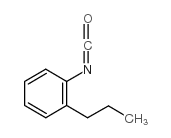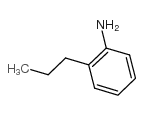2-PROPYLPHENYL ISOCYANATE
Modify Date: 2025-09-06 17:42:19

2-PROPYLPHENYL ISOCYANATE structure
|
Common Name | 2-PROPYLPHENYL ISOCYANATE | ||
|---|---|---|---|---|
| CAS Number | 190774-57-3 | Molecular Weight | 161.20000 | |
| Density | 1.01 | Boiling Point | 50ºC (0.1 mmHg) | |
| Molecular Formula | C10H11NO | Melting Point | N/A | |
| MSDS | N/A | Flash Point | 85ºC | |
| Name | 1-isocyanato-2-propylbenzene |
|---|---|
| Synonym | More Synonyms |
| Density | 1.01 |
|---|---|
| Boiling Point | 50ºC (0.1 mmHg) |
| Molecular Formula | C10H11NO |
| Molecular Weight | 161.20000 |
| Flash Point | 85ºC |
| Exact Mass | 161.08400 |
| PSA | 29.43000 |
| LogP | 2.60640 |
| Vapour Pressure | 0.0644mmHg at 25°C |
| Index of Refraction | 1.521-1.523 |
| InChIKey | NSGTVMQTRFUUSL-UHFFFAOYSA-N |
| SMILES | CCCc1ccccc1N=C=O |
Synonym:None Section 2 - COMPOSITION, INFORMATION ON INGREDIENTS
Risk Phrases: 20/21/22 36/37/38 Section 3 - HAZARDS IDENTIFICATION EMERGENCY OVERVIEW
Harmful by inhalation, in contact with skin and if swallowed. Irritating to eyes, respiratory system and skin.Moisture sensitive.Lachrymator (substance which increases the flow of tears). Potential Health Effects Eye: Causes eye irritation. Lachrymator (substance which increases the flow of tears). May cause chemical conjunctivitis. Skin: Causes skin irritation. Organic isocyanates can cause local irritation and allergic reactions. Ingestion: May cause gastrointestinal irritation with nausea, vomiting and diarrhea. The toxicological properties of this substance have not been fully investigated. Inhalation: Causes respiratory tract irritation. The toxicological properties of this substance have not been fully investigated. At high concentrations, isocyanates affect mucous membranes of the respiratory tract and may lead to fatal pulmonary edema. Exposure to low and often even unmeasurable isocyanate concentration results in sensitization. Can produce delayed pulmonary edema. Chronic: Effects may be delayed. Chronic overexposure to isocyanates has been reported to cause lung damage, including decreased lung fuction, which may be permanent. Section 4 - FIRST AID MEASURES Eyes: Flush eyes with plenty of water for at least 15 minutes, occasionally lifting the upper and lower eyelids. Get medical aid. Do NOT allow victim to rub eyes or keep eyes closed. Skin: Get medical aid. Flush skin with plenty of water for at least 15 minutes while removing contaminated clothing and shoes. Wash clothing before reuse. Destroy contaminated shoes. Ingestion: Get medical aid. Do NOT induce vomiting. If conscious and alert, rinse mouth and drink 2-4 cupfuls of milk or water. Inhalation: Remove from exposure and move to fresh air immediately. If not breathing, give artificial respiration. If breathing is difficult, give oxygen. Get medical aid. Do NOT use mouth-to-mouth resuscitation. If breathing has ceased apply artificial respiration using oxygen and a suitable mechanical device such as a bag and a mask. Notes to Physician: Treat symptomatically and supportively. Section 5 - FIRE FIGHTING MEASURES General Information: As in any fire, wear a self-contained breathing apparatus in pressure-demand, MSHA/NIOSH (approved or equivalent), and full protective gear. During a fire, irritating and highly toxic gases may be generated by thermal decomposition or combustion. Extinguishing Media: Use agent most appropriate to extinguish fire. Do NOT get water inside containers. Use water spray, dry chemical, carbon dioxide, or appropriate foam. Section 6 - ACCIDENTAL RELEASE MEASURES General Information: Use proper personal protective equipment as indicated in Section 8. Spills/Leaks: Clean up spills immediately, observing precautions in the Protective Equipment section. Sweep up or absorb material, then place into a suitable clean, dry, closed container for disposal. Provide ventilation. Do not get water inside containers. Section 7 - HANDLING and STORAGE Handling: Wash thoroughly after handling. Avoid contact with eyes, skin, and clothing. Keep container tightly closed. Avoid ingestion and inhalation. Use with adequate ventilation. Do not allow contact with water. Wash clothing before reuse. Keep from contact with moist air and steam. Storage: Store in a tightly closed container. Store in a cool, dry, well-ventilated area away from incompatible substances. Store protected from moisture. Section 8 - EXPOSURE CONTROLS, PERSONAL PROTECTION Engineering Controls: Facilities storing or utilizing this material should be equipped with an eyewash facility and a safety shower. Use adequate ventilation to keep airborne concentrations low. Exposure Limits CAS# 190774-57-3: Personal Protective Equipment Eyes: Wear appropriate protective eyeglasses or chemical safety goggles as described by OSHA's eye and face protection regulations in 29 CFR 1910.133 or European Standard EN166. Skin: Wear appropriate protective gloves to prevent skin exposure. Clothing: Wear appropriate protective clothing to prevent skin exposure. Respirators: A respiratory protection program that meets OSHA's 29 CFR 1910.134 and ANSI Z88.2 requirements or European Standard EN 149 must be followed whenever workplace conditions warrant respirator use. Section 9 - PHYSICAL AND CHEMICAL PROPERTIES Physical State: Clear liquid Color: colorless to light yellow Odor: Not available. pH: Not available. Vapor Pressure: Not available. Viscosity: Not available. Boiling Point: 50 deg C @ .05 mmHg Freezing/Melting Point: Not available. Autoignition Temperature: Not available. Flash Point: 185 deg F ( 85.00 deg C) Explosion Limits, lower: Not available. Explosion Limits, upper: Not available. Decomposition Temperature: Solubility in water: Specific Gravity/Density: Molecular Formula: C10H11NO Molecular Weight: 161.20 Section 10 - STABILITY AND REACTIVITY Chemical Stability: Stable at room temperature in closed containers under normal storage and handling conditions. Conditions to Avoid: Incompatible materials, moisture, excess heat. Incompatibilities with Other Materials: Strong oxidizing agents, strong acids, strong bases, moisture. Hazardous Decomposition Products: Carbon monoxide, oxides of nitrogen, irritating and toxic fumes and gases, carbon dioxide. Hazardous Polymerization: Has not been reported Section 11 - TOXICOLOGICAL INFORMATION RTECS#: CAS# 190774-57-3 unlisted. LD50/LC50: Not available. Carcinogenicity: 2-N-propylphenyl Isocyanate - Not listed by ACGIH, IARC, or NTP. Section 12 - ECOLOGICAL INFORMATION Section 13 - DISPOSAL CONSIDERATIONS Dispose of in a manner consistent with federal, state, and local regulations. Section 14 - TRANSPORT INFORMATION IATA Shipping Name: ISOCYANATES, TOXIC, N.O.S.* Hazard Class: 6.1 UN Number: 2206 Packing Group: III IMO Shipping Name: ISOCYANATES, TOXIC, N.O.S. Hazard Class: 6.1 UN Number: 2206 Packing Group: III RID/ADR Shipping Name: ISOCYANATES, TOXIC, N.O.S. Hazard Class: 6.1 UN Number: 2206 Packing group: III Section 15 - REGULATORY INFORMATION European/International Regulations European Labeling in Accordance with EC Directives Hazard Symbols: XN Risk Phrases: R 20/21/22 Harmful by inhalation, in contact with skin and if swallowed. R 36/37/38 Irritating to eyes, respiratory system and skin. Safety Phrases: S 26 In case of contact with eyes, rinse immediately with plenty of water and seek medical advice. S 28A After contact with skin, wash immediately with plenty of water. S 36/37/39 Wear suitable protective clothing, gloves and eye/face protection. S 37 Wear suitable gloves. S 45 In case of accident or if you feel unwell, seek medical advice immediately (show the label where possible). WGK (Water Danger/Protection) CAS# 190774-57-3: No information available. Canada None of the chemicals in this product are listed on the DSL/NDSL list. CAS# 190774-57-3 is not listed on Canada's Ingredient Disclosure List. US FEDERAL TSCA CAS# 190774-57-3 is not listed on the TSCA inventory. It is for research and development use only. SECTION 16 - ADDITIONAL INFORMATION N/A |
| Hazard Codes | Xn:Harmful; |
|---|---|
| Risk Phrases | R20/21/22;R36/37/38;R42 |
| Safety Phrases | S23-S26-S36/37/39-S45 |
| RIDADR | UN 2206 |
| HS Code | 2929109000 |
|
~% 
2-PROPYLPHENYL ... CAS#:190774-57-3 |
| Literature: Bioorganic and Medicinal Chemistry, , vol. 17, # 23 p. 8102 - 8112 |
| Precursor 2 | |
|---|---|
| DownStream 0 | |
| HS Code | 2929109000 |
|---|---|
| Summary | 2929109000. other isocyanates. VAT:17.0%. Tax rebate rate:13.0%. . MFN tariff:6.5%. General tariff:30.0% |
| 2-propylbenzenisocyanate |
| MFCD00673045 |
| 2-n-propylphenyl isocyanate |
| 2-Propylphenyl isocyanate |

